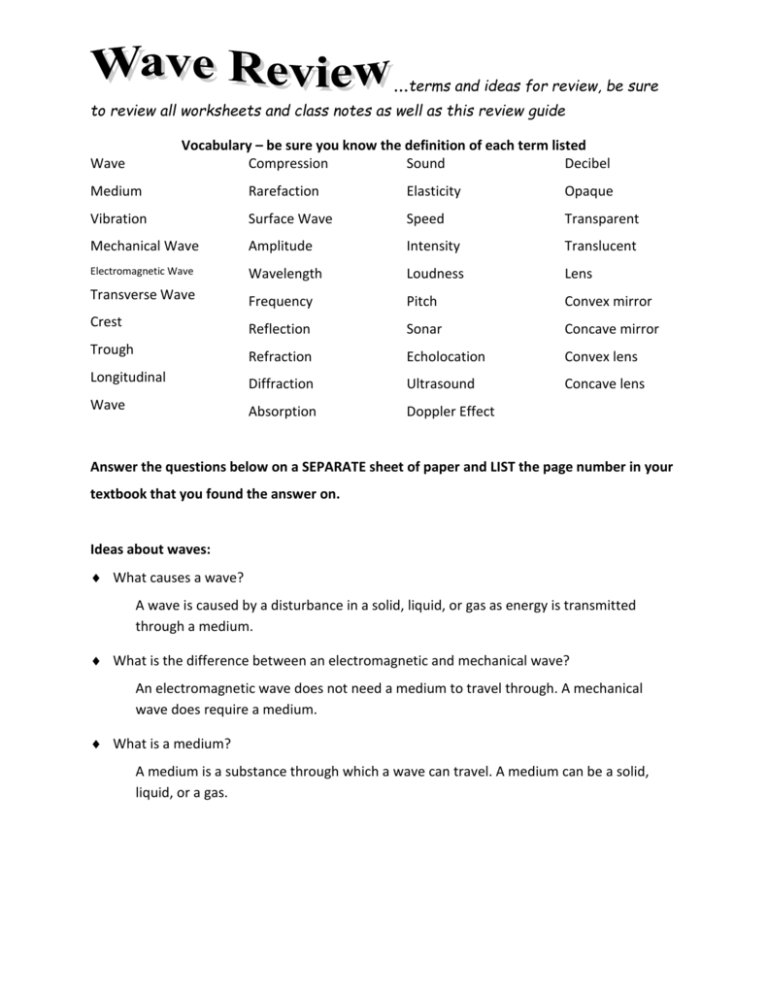Wave Review Guide: Sound, Light, and Wave Properties
advertisement

...terms and ideas for review, be sure to review all worksheets and class notes as well as this review guide Vocabulary – be sure you know the definition of each term listed Compression Sound Decibel Wave Medium Rarefaction Elasticity Opaque Vibration Surface Wave Speed Transparent Mechanical Wave Amplitude Intensity Translucent Electromagnetic Wave Wavelength Loudness Lens Transverse Wave Frequency Pitch Convex mirror Crest Reflection Sonar Concave mirror Trough Refraction Echolocation Convex lens Longitudinal Diffraction Ultrasound Concave lens Wave Absorption Doppler Effect Answer the questions below on a SEPARATE sheet of paper and LIST the page number in your textbook that you found the answer on. Ideas about waves: What causes a wave? A wave is caused by a disturbance in a solid, liquid, or gas as energy is transmitted through a medium. What is the difference between an electromagnetic and mechanical wave? An electromagnetic wave does not need a medium to travel through. A mechanical wave does require a medium. What is a medium? A medium is a substance through which a wave can travel. A medium can be a solid, liquid, or a gas. What are the differences and similarities between transverse, longitudinal and surface waves? What are the different parts of each wave? Can you draw and label them? Transverse, Longitudinal, and Surface waves all transfer energy by repeated vibrations. Transverse waves: Waves that move the medium at right angles to the direction in which the wave is moving. Particles move up and down. Longitudinal waves: Waves that move the medium parallel to the direction in which the wave is moving. Particles move back and forth. Surface waves: A wave that is a combination of both a longitudinal and transverse wave. Particles in a surface wave move in circles. Parts of transverse wave: Parts of a longitudinal wave: What is frequency? What is it measured in? Frequency is the number of waves produced in a given amount of time. It is measured in hertz (Hz). What is amplitude? Amplitude is the maximum distance that the particles of a medium vibrate from their rest position. How is wavelength measured in a transverse wave? Longitudinal? The wavelength of a transverse wave is the distance between two crests or troughs. The wavelength of a longitudinal wave is the distance between two compressions or rarefactions. How do we calculate wave speed? Wave speed is calculated by multiplying the wavelength times the frequency. What happens to a have that is reflected, refracted, diffracted or absorbed? When a wave is reflected, it bounces back after hitting a barrier. When a wave is refracted, the wave is bent as it passes from one medium to another at an angle. When a wave is diffracted, the wave bends around the barrier or through an opening. When a wave is absorbed, the wave is taken in by the matter that it comes in contact with. Ideas about sound: Is sound an electromagnetic or mechanical wave? Transverse or longitudinal? Sound is a mechanical and a longitudinal wave. How does the speed of a sound wave change depending on the elasticity, density or temperature of the medium it is traveling through? Elasticity – sound travels the fastest through solids, slowest in gases Density – Sound travels fastest in the least dense medium of a particular state of matter Temperature – sound travels faster as temperature rises In what state of matter does speed travel the fastest in? the slowest? Sound travels fastest in a solid. It travels slowest in a gas. How does sound reach us? Sound reaches us by vibrating the particles of the medium that it is traveling through. How does frequency affect the sounds we hear? Higher frequency sounds will have a higher pitch (like a bat screech). Lower frequency sounds will have a lower pitch (like a bass guitar). What changes the loudness of a sound? Amplitude affects the loudness of a sound. The higher the amplitude, the louder the sound. What is loudness measured in? Loudness is measured in decibels (dB). What is intensity? Intensity refers to how loud a sound or how much energy it is carrying. Give an example of sound being refracted, reflected and diffracted. An echo is an example of a reflected sound wave. Sound diffracts or bends around barriers well; this is why you can hear it from another room.







